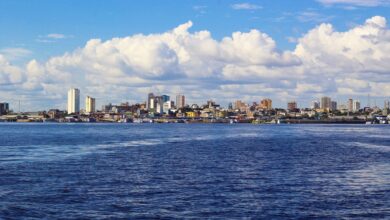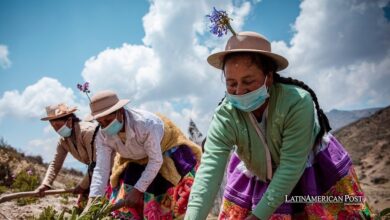What Are Climate Refuges And Why Are They Important?
Experts are discovering regions of the world with microenvironments with ideal conditions to serve as a refuge for different species in the face of climate change. Find out what you need to know about this topic.

Photo: National Geographic
LatinAmerican Post | Joshua Radesca
Escucha este artículo
Leer en español: ¿Qué son los refugios climáticos y cuál es su importancia ante el calentamiento global?
Climate change is one of the issues that most concerns experts, institutions, governments and private individuals. Its impact on natural environments is undeniable, where it affects plants and animals. Greenpeace estimates that 3,300 hectares of ice tongues that existed at the beginning of the 20th century in the Pyrenees have been reduced to only 390. For its part, the World Meteorological Organization indicates that in recent years the average global temperature was approximately 1, 2°C above pre-industrial levels (1850-1900), and that the decade from 2011 to 2020 was the warmest ever recorded.
"Climate change is affecting essential processes of many organisms, such as growth, reproduction and survival of the first vital phases, and may even compromise the viability of some populations," Greenpeace warns.
However, many species have found refuge in spaces that cushion the effects of climate change and provide the necessary conditions to survive. These can be defined as climate micro-shelters. According to a report from the University of Zaragoza, these are “small patches in the territory with favorable environmental characteristics for certain organisms that allow them to live outside their main distributions, where conditions are or have become unfavorable for them. These are areas characterized by stable climatic conditions, giving many species the opportunity to persist long-term in times of climate change.”
Numerous investigations are identifying and studying these spaces. Find out what some of these climate havens are around the world.
Penguins in the Weddell Sea
Antarctica is one of the regions most affected by climate change, causing penguin populations to decline more and more. According to data provided by Greenpeace, the populations of white-faced penguins on Elephant Island have been reduced by 77% in the last fifty years.
However, in January, a Greenpeace expedition with scientists aboard Stony Brook University in New York discovered in the Weddell Sea (a large portion of the South Atlantic Ocean in Antarctica) that in the last decade penguin populations have been stable on three islands. More than 40,000 Adélie penguin chicks were found on Devil Island, Vortex Island, and Penguin Point.
According to the researchers, this may be due to a huge set of ice sheets present in the region and little fishing activity, which creates ideal conditions for the subsistence of these penguins.
“The Weddell Sea is hardly immune to climate change, but it appears that the Adélie penguins that breed in this area remain protected from the worst of the threats facing those rapidly declining populations on the western side of the peninsula. Antarctica, where temperatures are rising. Our understanding of the ecology in this inhospitable landscape continues to grow each year, but everything we learn points toward its conservation value,” said Heather J. Lynch, a professor at Stony Brook University and one of the expedition leaders.
The Fageda d'en Jordà
An investigation led by Jofre Carnicer, Professor of Ecology at the University of Barcelona and member of the Center for Ecological Research and Forestry Applications (CREAF), has discovered a climate refuge in the Fageda d'en Jordà, a nature reserve made up of a forest of beeches with unique characteristics in Spain. Under the canopy of beeches, a microclimate is generated that can be 5 ºC cooler than its surroundings. This is a favorable environment for the White Verdinervada butterfly and in which it can both reproduce and grow easily. This contrasts with the fact that these butterflies are in decline in various parts of Catalonia, as a result of climate change.
Also read: UN Global Ocean Treaty negotiations failed
Yosemite park
In California, climate change has a notable impact, since it is conducive to droughts and intense fires. However, research such as that carried out by Toni Lyn Morelli, a researcher at the Northeast Climate Adaptation Science Center, has identified various climate refuges within the Yosemite Natural Park, which include part of the Sierra Nevada. These serve as shelter for a particular species of rodent typical of the area, the Belding ground squirrel (Urocitellus beldingi), whose population remains stable in these spaces.
Canada boreal forest
One of the ecosystems that is most impacted by climate change are boreal forests. About 30% of them are in Canada and represent 75% of the forest area in this country. Climate change makes fires more and more frequent in these. Studies such as those carried out by the University of Alberta have managed to locate spaces in these forests that act as a climatic refuge for wildlife. Likewise, places that are more resilient to fires have been identified.
Canadian boreal forest lakes have also been studied. These “absorb the heat and reduce the temperature in the area, acting as if they were an air conditioner that cools the landscape. The climate models did not take this effect of the lakes into account, but now we know that in the future they will be able to cushion the increase in temperatures in the area a little, ”says Diana Stralberg of the Canadian Forest Service.
In short, the recognition and study of these microclimates that serve as refuges is of great importance, since, as the University of Zaragoza report explains, “The loss of biodiversity is one of the most important consequences of climate change. For this reason, knowing the areas that would allow certain organisms to survive in the current scenario of global warming constitutes a first step in the conservation of biodiversity”.




